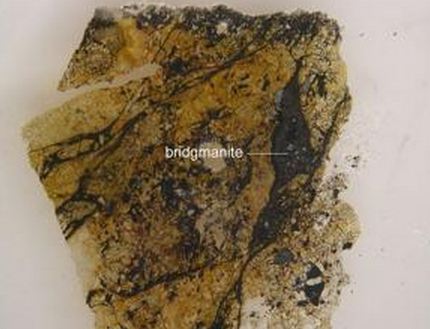For the first time, scientists have given a name to the “silicate mineral with a perovskite structure” that is the most abundant the Earth has: bridgmanite.
According to a Caltech press release, Chi Ma and Oliver Tschauner teamed up to analyze the naturally formed mineral, originally found in a meteorite. Bridgmanite is known to be present in the Earth’s lower mantle, but scientists have only been able to study synthetic samples until this study.
The mineral, dubbed bridgmanite, is named in honor of Percy Bridgman, a physicist who won the 1946 Nobel Prize in Physics for his fundamental contributions to high-pressure physics.
“The most abundant mineral of the earth now has an official name,” says Chi Ma, a mineralogist and director of the Geological and Planetary Sciences division’s Analytical Facility at Caltech.
“This finding fills a vexing gap in the taxonomy of minerals,” adds Oliver Tschauner, an associate research professor at the University of Nevada-Las Vegas who identified the mineral together with Ma.
High-pressure and temperature experiments, as well as seismic data, strongly suggest that (Mg,Fe)SiO3-perovskite—now simply called bridgmanite—is the dominant material in the lower mantle. But since it is impossible to get to the earth’s lower mantle, located some 400 miles deep within the planet and rocks brought to the earth’s surface from the lower mantle are exceedingly rare, naturally occurring examples of this material had never been fully described.
That is until Ma and Tschauner began poking around a sample from the Tenham meteorite, a space rock that fell in Australia in 1879.
Because the 4.5 billion-year-old meteorite had survived high-energy collisions with asteroids in space, parts of it were believed to have experienced the high-pressure conditions we see in the earth’s mantle. That, scientists thought, made it a good candidate for containing bridgmanite.
Tschauner used synchrotron X-ray diffraction mapping to find indications of the mineral in the meteorite. Ma then examined the mineral and its surroundings with a high-resolution scanning electron microscope and determined the composition of the tiny bridgmanite crystals using an electron microprobe. Next, Tschauner analyzed the crystal structure by synchrotron diffraction. After five years and multiple experiments, the two were finally able to gather enough data to reveal bridgmanite’s chemical composition and crystal structure.
“It is a really cool discovery,” says Ma. “Our finding of natural bridgmanite not only provides new information on shock conditions and impact processes on small bodies in the solar system, but the tiny bridgmanite found in a meteorite could also help investigations of phase transformation mechanisms in the deep Earth. ”
The mineral and the mineral name were approved on June 2 by the International Mineralogical Association’s Commission on New Minerals, Nomenclature and Classification.
Agencies/Canadajournal
 Canada Journal – News of the World Articles and videos to bring you the biggest Canadian news stories from across the country every day
Canada Journal – News of the World Articles and videos to bring you the biggest Canadian news stories from across the country every day



